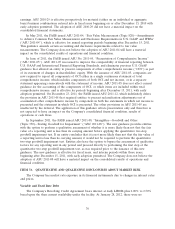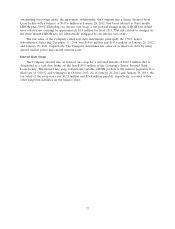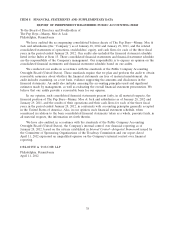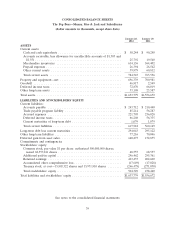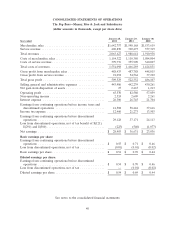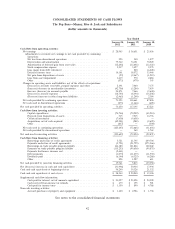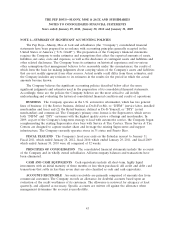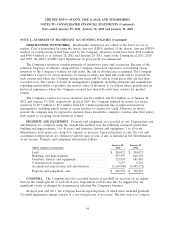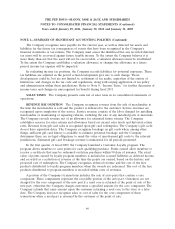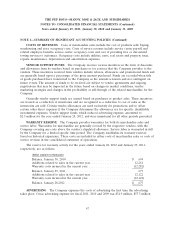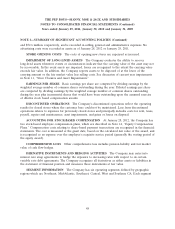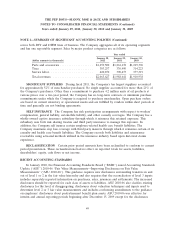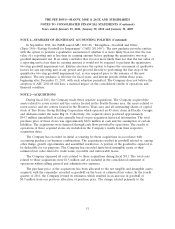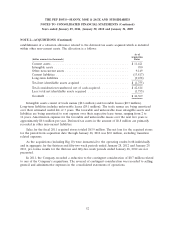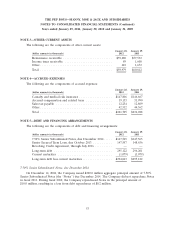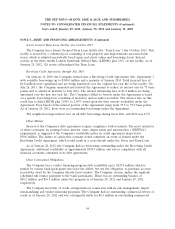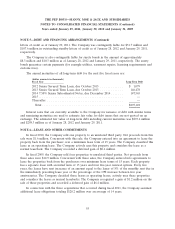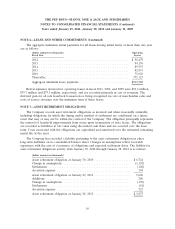Pep Boys 2011 Annual Report Download - page 90
Download and view the complete annual report
Please find page 90 of the 2011 Pep Boys annual report below. You can navigate through the pages in the report by either clicking on the pages listed below, or by using the keyword search tool below to find specific information within the annual report.THE PEP BOYS—MANNY, MOE & JACK AND SUBSIDIARIES
NOTES TO CONSOLIDATED FINANCIAL STATEMENTS (Continued)
Years ended January 29, 2011, January 30, 2010 and January 31, 2009
NOTE 1—SUMMARY OF SIGNIFICANT ACCOUNTING POLICIES (Continued)
The Company recognizes taxes payable for the current year, as well as deferred tax assets and
liabilities for the future tax consequences of events that have been recognized in the Company’s
financial statements or tax returns. The Company must assess the likelihood that any recorded deferred
tax assets will be recovered against future taxable income. To the extent the Company believes it is
more likely than not that the asset will not be recoverable, a valuation allowance must be established.
To the extent the Company establishes a valuation allowance or changes the allowance in a future
period, income tax expense will be impacted.
In evaluating income tax positions, the Company records liabilities for potential exposures. These
tax liabilities are adjusted in the period actual developments give rise to such change. Those
developments could be, but are not limited to, settlement of tax audits, expiration of the statute of
limitations, and changes in the tax code and regulations, along with varying application of tax policy
and administration within those jurisdictions. Refer to Note 8, ‘‘Income Taxes,’’ for further discussion of
income taxes and changes in unrecognized tax benefit during fiscal 2011.
SALES TAXES The Company presents sales net of sales taxes in its consolidated statements of
operations.
REVENUE RECOGNITION The Company recognizes revenue from the sale of merchandise at
the time the merchandise is sold and the product is delivered to the customer. Service revenues are
recognized upon completion of the service. Service revenue consists of the labor charged for installing
merchandise or maintaining or repairing vehicles, excluding the sale of any installed parts or materials.
The Company records revenue net of an allowance for estimated future returns. The Company
establishes reserves for sales returns and allowances based on current sales levels and historical return
rates. Revenue from gift card sales is recognized upon gift card redemption. The Company’s gift cards
do not have expiration dates. The Company recognizes breakage on gift cards when, among other
things, sufficient gift card history is available to estimate potential breakage and the Company
determines there are no legal obligations to remit the value of unredeemed gift cards to the relevant
jurisdictions. Estimated gift card breakage revenue is immaterial for all periods presented.
In the first quarter of fiscal 2009, the Company launched a Customer Loyalty program. The
program allows members to earn points for each qualifying purchase. Points earned allow members to
receive a certificate that may be redeemed on future purchases within 90 days of issuance. The retail
value of points earned by loyalty program members is included in accrued liabilities as deferred income
and recorded as a reduction of revenue at the time the points are earned, based on the historic and
projected rate of redemption. The Company recognizes deferred revenue and the cost of the free
products distributed to loyalty program members when the awards are redeemed. The cost of the free
products distributed to program members is recorded within costs of revenues.
A portion of the Company’s transactions includes the sale of auto parts that contain a core
component. These components represent the recyclable portion of the auto part. Customers are not
charged for the core component of the new part if a used core is returned at the point of sale of the
new part; otherwise the Company charges customers a specified amount for the core component. The
Company refunds that same amount upon the customer returning a used core to the store at a later
date. The Company does not recognize sales or cost of sales for the core component of these
transactions when a used part is returned by the customer at the point of sale.
46


